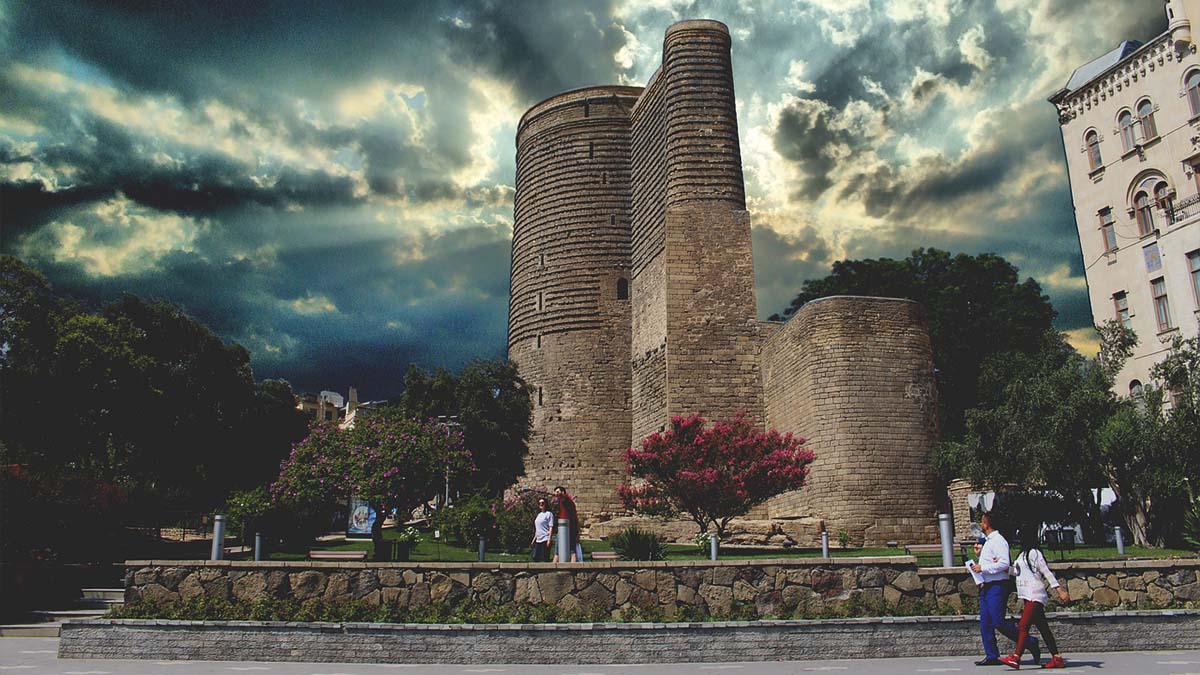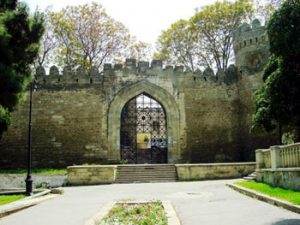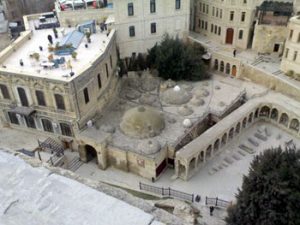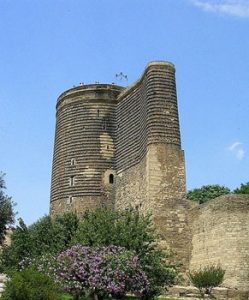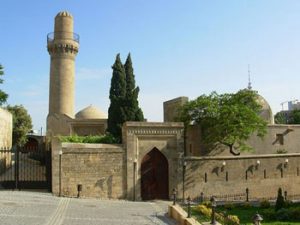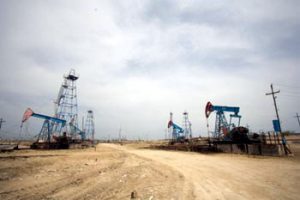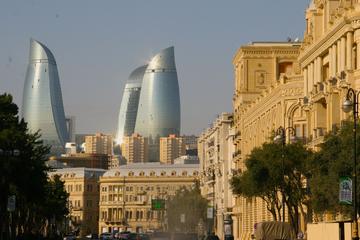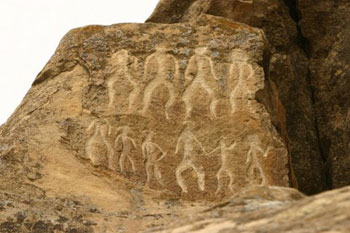
by Rusif Huseynov
Starting our trip from Baku, the capital of Azerbaijan with my brother I head south. The road along the beautiful shore of the Caspian Sea leads to Gobustan, one of the famous historical and mystic landmarks of the country. As children we were taken there once by our parents. But then a child’s outlook was not so capable to understand and estimate what we saw. Now it seems more exciting to go, walk around and explore.
Gobustan, which name in translation means “Ravine Land,” has a distinctive relief and full of muddy volcanoes. But that’s not the main thing that attracts thousands of tourists every year. That’s not what I and my brother want to see now.
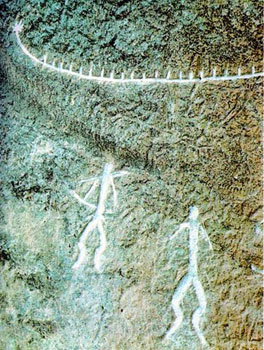 Declared a UNESCO World Heritage Site, Gobustan contains unique rock art engravings and images depicting the lifestyle, culture, economy, world outlook, magic and totemic conception, customs and traditions of the ancient inhabitants of the area. Long time ago the sea waves licked these mountains and then abandoned them leaving characteristic relief traces on the polished rocks.
Declared a UNESCO World Heritage Site, Gobustan contains unique rock art engravings and images depicting the lifestyle, culture, economy, world outlook, magic and totemic conception, customs and traditions of the ancient inhabitants of the area. Long time ago the sea waves licked these mountains and then abandoned them leaving characteristic relief traces on the polished rocks.
It takes us about an hour to reach the destination. A local guide offers her help, but we kindly reject. Sometimes it is much better to explore the area alone, trying to “read” what our forefathers have left for us, remembering the history of the discovery of Gobustan.
The petroglyphs of Gobustan were not discovered by an archeological expedition. In fact, their revelation came about quite by accident. In the 1930s, work was going on there in a stone quarry. The area is full of huge boulders and rock formations. One of the quarry workers noticed some unusual carvings on the rocks. The more the rocks were cut out, the more the paintings could be seen. (Before they had been hidden from view inside a huge pile of boulders.) Even more paintings were found inside what appeared to be man-made caves. Work at the quarry soon stopped so that the paintings could be examined more carefully. In the late 1930s the archeological investigations started. The scientists identified and documented approximately thousands of individual rock paintings during the next decades.
Gobustan has witnessed the life of area inhabitants from the prehistoric times through the Middle Ages till the modern era. Thousands of petroglyphs have been discovered in Gobustan. And that’s not all, the scientists think. Most of those rock engravings date back to the Stone Age. However, depicting petroglyphs continued till the Middle Ages.
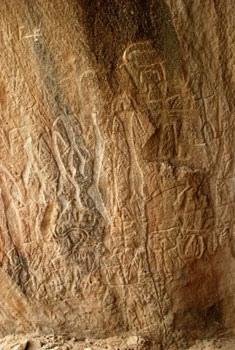 Gobustan rock carvings are marked with thematic diversity, plot originality, and certain artistic skill. Most of the petroglyphs depict people, domestic and wild animals, such as oxen, goats, gazelles, deer, horses, birds, fish, as well as battle scenes, ritual dances, bullfights, boats with men, hunting, fishing, solar symbols, etc.
Gobustan rock carvings are marked with thematic diversity, plot originality, and certain artistic skill. Most of the petroglyphs depict people, domestic and wild animals, such as oxen, goats, gazelles, deer, horses, birds, fish, as well as battle scenes, ritual dances, bullfights, boats with men, hunting, fishing, solar symbols, etc.
Whenever I come here, no matter it is my first or second or tenth visit, I feel that I am going to discover something new. Because this museum under open sky still hides a lot of secrets. It makes indescribable impressions to wander here in calm, to see all what the cold rocks have kept to themselves for millennia, to imagine all the scenes depicted by the pre-historic humans of this area.
Sometimes it feels and seems like the people and animals depicted on rocks are alive: the boatmen oar their boats, the hunters chase a wild gazelle, people perform a ritual dance, the bulls are ready to fight.
A lot of petroglyphs depict humans differently depending on the eras when they were made. Not skilled artists, however, the ancient drawers could distinguish men and women on their “masterpieces.” The women are naked, with big bosoms, narrow waists, wide hips, and thick legs. My brother sees and shows me some tattooed women. Probably those women had a higher status in the tribe. The men are presented as tall people with strong legs and muscular bodies. In many pictures they have weapons, such as bows and arrows in their hands.
Some rocks contain engravings depicting ritual dances. A similar row dance, known as “Yalli” in Azerbaijan, “Halay” in Turkey, is still performed here in Azerbaijan. I remind my brother how many times we have joined the people performing “Yalli”, which means unity and strength, at wedding parties. The petroglyphs show that it was a sacred ritual for our forefathers, who probably performed it around fire or before going to hunting.
The famous Norwegian traveler and explorer Thor Heyerdahl visited Gobustan several times throughout his life and emphasized the resemblance the Gobustan rock engravings with the petroglyphs discovered in Scandinavia. He tried to find the relations between the petroglyphs in two different parts of the world, and even proposed some hypotheses about the ties between the Vikings and Gobustan inhabitants.
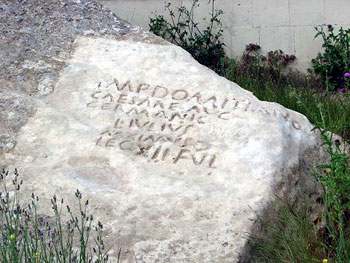 Personally, I am not sure about the presence of the Vikings in these areas. But the Romans were for sure. A rock found in Gobustan contains a Roman inscription which proves the presence of a centurion of the XII (12th) Roman legion, known as the Fulminat (Lightning) here on the shore of the Caspian Sea during the reign of Emperor Titus Flavius Domitianus in the second half the 1st century AD. Some assume, this may be the easternmost point any Roman patrol even ventured to. I can read the inscription though I am not good in Latin: “IMP DOMITIANO CAESARE AVG GERMANIC LIVIVS MAXIMVS LEG XII FVL” (“Emperor Domitian, the Blessed Caesar Germanicus. Livius Maximus, Legio XII Fulminata”).
Personally, I am not sure about the presence of the Vikings in these areas. But the Romans were for sure. A rock found in Gobustan contains a Roman inscription which proves the presence of a centurion of the XII (12th) Roman legion, known as the Fulminat (Lightning) here on the shore of the Caspian Sea during the reign of Emperor Titus Flavius Domitianus in the second half the 1st century AD. Some assume, this may be the easternmost point any Roman patrol even ventured to. I can read the inscription though I am not good in Latin: “IMP DOMITIANO CAESARE AVG GERMANIC LIVIVS MAXIMVS LEG XII FVL” (“Emperor Domitian, the Blessed Caesar Germanicus. Livius Maximus, Legio XII Fulminata”).
Apart from petroglyphs, there is also a musical gemstone known as the Gaval Dash or Tambourine stone as they call it in English. It makes a tambourine-like sound when it is hit in different points. Visitors attending this site never leave without playing on it. Musical sounds come from the Gaval Dash when touching it with a small stone. The Gaval Dash has been formed due the combination of unique climate, oil and gas which can be found in the region of Azerbaijan. Of course, I played on this witness of millennia too, wishing the air of Gobustan to keep my melodies for many years from now.
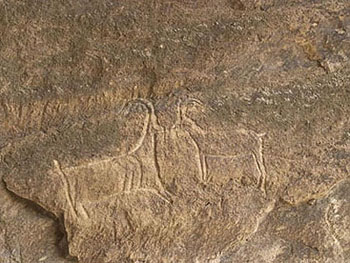 Near the end of our trip I ask my brother whether he would like to see the “Gobustan kitchen”. He first think I am joking. But I am not. I take him to the place I have read about many times and show him the bowl-shaped depressions carved out in the rock. They were probably used for collecting rainwater, the blood of sacrificed animals or for cooking. I remember from the old people that until quite recently mountain shepherds used these “bowls” for boiling milk by dropping heated stones into them. It may be an explanation about the usage of similar “bowls” by the prehistoric people.
Near the end of our trip I ask my brother whether he would like to see the “Gobustan kitchen”. He first think I am joking. But I am not. I take him to the place I have read about many times and show him the bowl-shaped depressions carved out in the rock. They were probably used for collecting rainwater, the blood of sacrificed animals or for cooking. I remember from the old people that until quite recently mountain shepherds used these “bowls” for boiling milk by dropping heated stones into them. It may be an explanation about the usage of similar “bowls” by the prehistoric people.
Gobustan is considered one of the symbols of Azerbaijan. It is more than just a museum or a landmark. I dare to call the place an honor for the nation. The Gobustan rocks are depicted on national postcards, stamps and even on the reverse of the 2006 series of the national currency banknotes, manat. Whenever you visit Azerbaijan, don’t forget to attend Gobustan. Or don’t worry about forgetting, because you will be reminded, even taken there by hospitable local people.
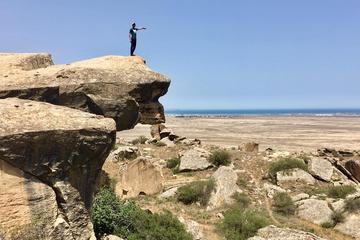
Gobustan Rock Art Museum and Mud Volcano
If You Go:
If you are traveling from Baku you can reach Gobustan on the bus to Alat. It is easy to take a taxi or rent a car. It will take you 40-60 minutes to reach the destination. The main petroglyphs site is about five kilometers west of the settlement of Gobustan itself. Plan your journey carefully as currently there is no hotel in Gobustan.
Gobustan National Historical Preserve
3 Lermontov Str.
Baku, AZ 1006, Azerbaijan
Tel: +994 12 492 61 45
Fax: +994 12) 492 02 54
General Office:
office@gobustan-rockart.az
Work time: 10.30 am – 4.30 pm (daily)
About the author:
Rusif Huseynov was in Baku, Azerbaijan. He is interested in world history and geography. He speaks Azerbaijani (mother tongue), Russian, English, Turkish and some German. Among his hobbies are collecting postcards and key chains from different countries. One of his dreams is to travel all over the world.
All photos are by Rusif Huseynov.


